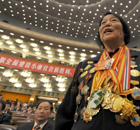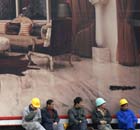-
-
China Daily E-paper
Li Xing
Even modern cities need distinction
By Li Xing (China Daily)
Updated: 2010-04-29 07:55
 |
Large Medium Small |
Five years ago, my family and I paid a visit to Xi'an, the ancient capital of China. We marveled at the army of terra cotta warriors and visited museums, tombs, and temples. We also rode bicycles on the city wall that still surrounds the old part of the city.
Even then, Xi'an was on a building spree. Construction equipment was everywhere as the city struggled to add more housing, as well as cultural facilities for both residents and tourists.
Last Sunday, I visited Xi'an again. I was amazed to see towering apartment complexes, a stunning new park with a lot of water features, and a huge new city center where people can enjoy concerts, movies and art exhibitions, as well as dining and shopping.
Still, construction equipment continues to dot the landscape. Don't be surprised, local official Wang Jun told me; Xi'an has set out to transform itself into one of the world's major metropolises.
Where have I heard that before? Since December, the phrase guoji da dushi (international metropolis) has been repeated on TV news broadcasts in Beijing, as officials here tout future development plans.
Beijing already is a major metropolis. It ranks high on almost every major index attempting to rate cities around the world according to their political influence, economic power, and cultural impact, as well as their livability, creativity and many other indicators.
One of the first such indices was the Globalization and World Cities Study Group and Network, based in Loughborough University in the UK. It publishes a list of the world's leading cities every four years, based on an analysis on what it calls "advanced producers services", such as accounting, advertising, finance and law. Beijing ranked 9th on its 2008 roster, after New York, London, Hong Kong, Paris, Singapore, Sydney, Tokyo, and Shanghai.
Foreign Policy, an American magazine, published a similar list in October 2008, in which its experts assessed "business activity, human capital, information exchange, cultural experience, and political engagement" in the world's top cities. Beijing ranked 11th, with New York and London leading the pack.
Beijing fell to 26th place in a Japanese study released last October. The Japanese focused on six categories: economy, research and development, cultural interaction, livability, environment, and accessibility.
No matter who you listen to, Beijing is a major metropolis, although it still trails cities like New York and London when it comes to environment and research and development.
It is commendable that Beijing has not rested on its laurels after hosting the 2008 Olympics. Instead, it has recognized its shortcomings and is now aiming to become a "highly developed" global city, in the words of Party chief Liu Qi, who has urged municipal officials to set more ambitious goals.
Beijing has paid a price for modernization, however. Glistening skyscrapers overshadow the Forbidden City and have squeezed out a lot of the old hutongs. Rampant development, endless sprawl, and ever more cars threaten to diminish the city's livability, and residents have reason to worry whether Beijing is losing its cultural and historic identity.
So far, Xi'an has managed to retain a lot of its ancient character. The city wall has been preserved, and parts of the old city are still visible. I was especially drawn to a classical brick carving at the entrance to a courtyard dwelling inhabited by local Hui Muslims. I was told that the owner had fought hard to keep the old house, along with the folk art.
Xi'an is unique. Countless ruins and ancient sites still exist to remind us of the glory of the ancient capital. I hope the city will not sacrifice these in its quest to join the ranks of the world's metropolises.
E-mail: lixing@chinadaily.com.cn
(China Daily 04/29/2010 page8)









